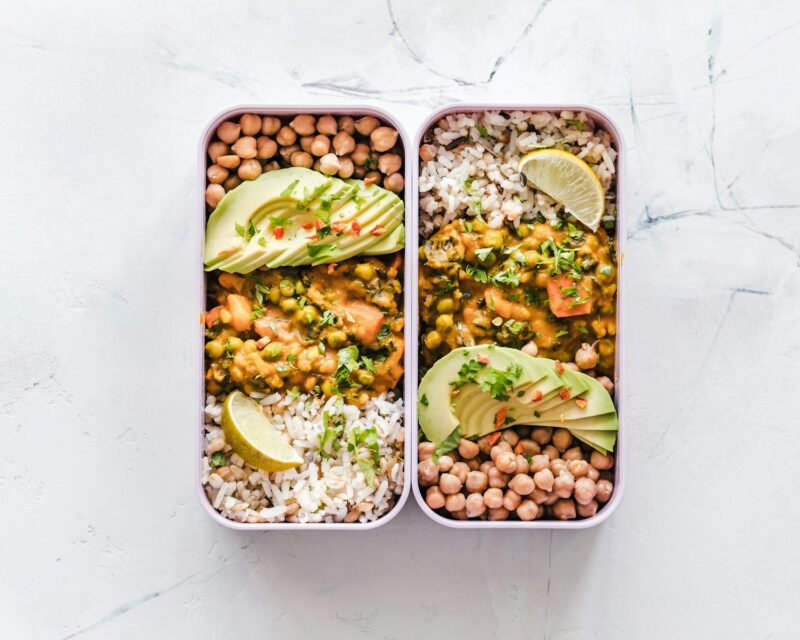Introduction: In today’s fast-paced world, finding time to prepare healthy meals can be challenging. However, with a little planning and preparation, you can enjoy nutritious and delicious meals throughout the week without the stress. Meal prepping is an excellent strategy for busy individuals looking to maintain a healthy diet. This blog post will provide practical tips and easy recipes to help you get started with healthy meal prep.
Benefits of Meal Prep: Meal prepping offers several benefits, making it a worthwhile practice for anyone looking to eat healthier:
- Saves Time: Prepping meals in advance saves time during the week, allowing you to focus on other tasks and activities.
- Promotes Healthy Eating: Having healthy meals ready to go reduces the temptation to opt for fast food or unhealthy snacks.
- Saves Money: Planning and prepping meals can help you stick to a budget and avoid costly takeout or restaurant meals.
- Reduces Stress: Knowing what you’ll be eating each day can reduce the stress of last-minute meal decisions.
Getting Started with Meal Prep:
1. Plan Your Meals: Start by planning your meals for the week. Consider your schedule and choose recipes that fit your lifestyle. Aim for a variety of proteins, vegetables, and whole grains to ensure balanced nutrition.
2. Make a Shopping List: Once you’ve planned your meals, create a shopping list of all the ingredients you’ll need. This helps you stay organized and ensures you have everything on hand for meal prep.
3. Set Aside Time: Dedicate a specific day or time for meal prep. Many people find that Sundays work well, but choose a time that fits your schedule. Allocate a few hours to prep, cook, and portion your meals.
4. Invest in Containers: Invest in a set of good-quality containers for storing your meals. Choose containers that are microwave-safe, freezer-safe, and leak-proof to keep your food fresh and convenient to reheat.
Healthy Meal Prep Tips:
1. Batch Cooking: Batch cooking involves preparing large quantities of a particular dish and dividing it into individual portions. This is efficient and ensures you have ready-to-eat meals throughout the week.
2. Use Versatile Ingredients: Choose ingredients that can be used in multiple dishes to save time and effort. For example, cooked chicken can be used in salads, wraps, and stir-fries.
3. Prep Ingredients in Advance: Chop vegetables, cook grains, and marinate proteins in advance. Having these components ready makes assembling meals quick and easy.
4. Focus on Balance: Ensure your meals are balanced with a good mix of protein, healthy fats, and complex carbohydrates. This helps keep you full and energized throughout the day.
5. Freeze Extras: If you have extra portions, freeze them for future use. This is particularly useful for soups, stews, and casseroles, which freeze well and can be reheated quickly.
Healthy Meal Prep Recipes:
1. Chicken and Vegetable Stir-Fry: Ingredients:
- 1 lb chicken breast, sliced into thin strips
- 2 cups broccoli florets
- 1 red bell pepper, sliced
- 1 carrot, julienned
- 2 tbsp soy sauce
- 1 tbsp olive oil
- 1 tsp garlic powder
- 1 tsp ginger powder
- Cooked brown rice
Instructions:
- Heat olive oil in a large skillet over medium-high heat.
- Add chicken strips and cook until browned, about 5-7 minutes.
- Add broccoli, bell pepper, and carrot to the skillet. Cook for an additional 5 minutes.
- Stir in soy sauce, garlic powder, and ginger powder. Cook for another 2-3 minutes until vegetables are tender.
- Serve over cooked brown rice and divide into meal prep containers.
2. Quinoa and Black Bean Salad: Ingredients:
- 1 cup quinoa, cooked
- 1 can black beans, rinsed and drained
- 1 cup cherry tomatoes, halved
- 1 avocado, diced
- 1/4 cup red onion, finely chopped
- 1/4 cup cilantro, chopped
- Juice of 1 lime
- 2 tbsp olive oil
- Salt and pepper to taste
Instructions:
- In a large bowl, combine cooked quinoa, black beans, cherry tomatoes, avocado, red onion, and cilantro.
- In a small bowl, whisk together lime juice, olive oil, salt, and pepper.
- Pour the dressing over the quinoa mixture and toss to combine.
- Divide into meal prep containers and refrigerate.
3. Turkey Meatballs with Zucchini Noodles: Ingredients:
- 1 lb ground turkey
- 1/4 cup breadcrumbs
- 1/4 cup grated Parmesan cheese
- 1 egg, beaten
- 2 garlic cloves, minced
- 1 tsp Italian seasoning
- 4 zucchinis, spiralized into noodles
- 2 cups marinara sauce
- 1 tbsp olive oil
- Salt and pepper to taste
Instructions:
- Preheat oven to 375°F (190°C).
- In a large bowl, combine ground turkey, breadcrumbs, Parmesan cheese, egg, garlic, Italian seasoning, salt, and pepper. Mix until well combined.
- Form the mixture into meatballs and place them on a baking sheet lined with parchment paper.
- Bake for 20-25 minutes, until the meatballs are cooked through.
- In a large skillet, heat olive oil over medium heat. Add zucchini noodles and cook for 2-3 minutes until slightly softened.
- Add marinara sauce to the skillet and stir to combine.
- Serve meatballs over zucchini noodles and divide into meal prep containers.
Conclusion: Healthy meal prep is an effective way to ensure you have nutritious and delicious meals ready to go, even on the busiest of days. By planning your meals, prepping ingredients in advance, and using versatile recipes, you can save time, reduce stress, and promote healthy eating habits. Start with the tips and recipes provided in this post, and customize your meal prep routine to fit your lifestyle and preferences. With a little practice, meal prepping can become a valuable tool for maintaining a balanced and healthy diet.
3. Understanding Nutritional Labels: What to Look For
Introduction: Navigating the world of nutritional labels can be daunting, but understanding them is crucial for making informed food choices. Nutritional labels provide valuable information about the contents of packaged foods, helping you assess their nutritional value and make healthier decisions. In this blog post, we’ll break down the components of a nutritional label and provide tips on what to look for when evaluating packaged foods.
The Basics of Nutritional Labels: Nutritional labels are standardized by regulatory authorities to provide consistent information about the nutrient content of foods. Here are the key components you’ll find on a nutritional label:
1. Serving Size: The serving size indicates the amount of food that the nutritional information is based on. It’s essential to compare this to the amount you actually eat, as the nutritional values will change if your portion size is different.
2. Calories: Calories measure the amount of energy you get from a serving of the food. Understanding calorie content can help you manage your energy intake, whether you’re aiming to maintain, lose, or gain weight.
3. Macronutrients: Macronutrients include carbohydrates, proteins, and fats. These are the primary sources of energy in your diet, and their amounts are listed in grams (g) per serving.
– Carbohydrates: This section is often broken down into total carbohydrates, dietary fiber, and sugars. Dietary fiber is important for digestive health, while sugars can impact blood sugar levels and overall health.
– Proteins: Protein is essential for building and repairing tissues, and it provides energy. Look for foods with a higher protein content if you’re looking to support muscle growth or recovery.
– Fats: Fats are divided into total fat, saturated fat, and trans fat. While some fats are necessary for health, others should be limited. Saturated and trans fats are associated with an increased risk of heart disease and should be consumed in moderation.
4. Micronutrients: Micronutrients include vitamins and minerals that are essential for various bodily functions. Commonly listed micronutrients include vitamin A, vitamin C, calcium, and iron. Aim to choose foods that provide a good source of these essential nutrients.
5. Percent Daily Value (%DV): The %DV indicates how much of a nutrient in a serving of food contributes to your daily recommended intake, based on a 2,000-calorie diet. This helps you gauge whether a food is high or low in a particular nutrient.
Interpreting Nutritional Labels: To make the most of nutritional labels, it’s important to know what to look for and how to interpret the information. Here are some tips:
1. Check the Serving Size: Always start by looking at the serving size. If you eat more or less than the serving size listed, you’ll need to adjust the nutritional values accordingly.
2. Assess Caloric Content: Consider the number of calories per serving in relation to your daily caloric needs. Foods that are high in calories may be suitable for energy-dense meals, while lower-calorie options are better for snacks or lighter meals.
3. Evaluate Macronutrient Balance: Look at the balance of carbohydrates, proteins, and fats. Aim for a mix that aligns with your dietary goals, such as higher protein for muscle building or higher fiber for digestive health.
4. Prioritize Fiber: Dietary fiber is important for maintaining healthy digestion and can help with weight management. Look for foods with at least 3 grams of fiber per serving.
5. Watch Out for Added Sugars: High levels of added sugars can contribute to weight gain and increase the risk of chronic diseases. Check for foods with low added sugar content, ideally less than 10% of the daily value.
6. Limit Unhealthy Fats: Reduce your intake of saturated and trans fats, which can raise cholesterol levels and increase the risk of heart disease. Opt for foods with unsaturated fats, such as those found in nuts, seeds, and avocados.
7. Consider Sodium Levels: High sodium intake is linked to high blood pressure and other health issues. Aim for foods with lower sodium content, ideally less than 140 mg per serving for a low-sodium option.
Common Nutritional Label Claims: In addition to the standard nutritional information, you may also encounter various claims on food packaging. Understanding these claims can help you make more informed choices:
1. “Low Fat” or “Reduced Fat”: These claims indicate that the product contains less fat than the standard version. However, be cautious, as these products may have added sugars or other ingredients to compensate for the reduced fat.
2. “High Fiber” or “Good Source of Fiber”: These claims suggest that the product contains a significant amount of fiber. Look for products with at least 5 grams of fiber per serving to qualify as “high fiber.”
3. “No Added Sugars” or “Sugar-Free”: “No added sugars” means that no additional sugars were included during processing, while “sugar-free” indicates that the product contains less than 0.5 grams of sugar per serving.
4. “Organic” or “Non-GMO”: “Organic” products are made without synthetic pesticides, fertilizers, or genetically modified organisms (GMOs). “Non-GMO” products do not contain genetically modified ingredients. Both labels can indicate a focus on natural ingredients.
5. “Low Sodium” or “No Salt Added”: “Low sodium” products contain 140 mg or less of sodium per serving, while “no salt added” means no salt was added during processing, though the product may still contain naturally occurring sodium.
Tips for Making Healthier Choices: Here are some additional tips to help you make healthier choices when evaluating nutritional labels:
1. Compare Products: When shopping, compare the nutritional labels of similar products to choose the one with better nutritional value. Look for options with lower calories, fats, and sugars, and higher fiber and protein content.
2. Read Ingredient Lists: Check the ingredient list for added sugars, unhealthy fats, and artificial additives. Ingredients are listed in descending order by weight, so those listed first are present in higher amounts.
3. Be Mindful of Portion Sizes: Be aware that the serving size listed may be smaller than the portion you typically consume. Adjust the nutritional information based on the portion you actually eat.
4. Use Apps and Tools: Consider using apps or online tools that can help you analyze nutritional labels and make healthier choices. Many apps allow you to scan barcodes and compare products easily.
Conclusion: Understanding nutritional labels is a key step toward making healthier food choices. By paying attention to serving sizes, caloric content, macronutrient balance, and other key components, you can better assess the nutritional value of packaged foods. Use the tips and strategies outlined in this post to become more confident in interpreting nutritional labels and making informed decisions that support your health and well-being. With practice, reading and understanding nutritional labels can become second nature, empowering you to take control of your diet and live a healthier life.
4. The Benefits of a Plant-Based Diet
Introduction: In recent years, plant-based diets have gained significant popularity, with more people choosing to reduce or eliminate animal products from their meals. A plant-based diet focuses on foods primarily from plants, including fruits, vegetables, nuts, seeds, oils, whole
4o









